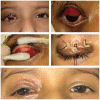Tarsal buckle with conjunctival prolapse following levator plication for unilateral congenital ptosis
- PMID: 29572371
- PMCID: PMC5878324
- DOI: 10.1136/bcr-2017-223743
Tarsal buckle with conjunctival prolapse following levator plication for unilateral congenital ptosis
Abstract
An 8-year-old child underwent uneventful levator plication surgery for unilateral congenital ptosis. Postoperative course for initial few days was uneventful but on day 7, the patient was brought with conjunctival prolapse from the undersurface of upper eyelid due to tarsal kinking and eversion. Early medical management was initiated with frequent surface lubrication to avoid conjunctiva dryness. Under general anaesthesia, right-sided conjunctival repositioning was performed with an eyelid spatula supplemented by three forniceal stay sutures to retain the conjunctiva in its anatomical place. To reverse the tarsal kinking, continued downward traction suture was placed for a period of 2 weeks. At the end of 4 weeks, the conjunctival prolapse was completely resolved with a well-formed superior fornix. At the end of 3 months, the symmetric eyelid position was maintained without any additional complications.
Keywords: medical education; ophthalmology; plastic and reconstructive surgery.
© BMJ Publishing Group Ltd (unless otherwise stated in the text of the article) 2018. All rights reserved. No commercial use is permitted unless otherwise expressly granted.
Conflict of interest statement
Competing interests: None declared.
Figures

References
-
- Wolfley DE. Preventing conjunctival prolapse and tarsal eversion following large excisions of levator muscle and aponeurosis for correction of congenital ptosis. Ophthalmic Surg 1987;18:491–4. - PubMed
Publication types
MeSH terms
LinkOut - more resources
Full Text Sources
Other Literature Sources
